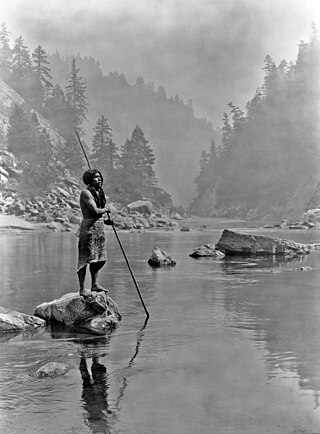
The Hupa are a Native American people of the Athabaskan-speaking ethnolinguistic group in northwestern California. Their endonym is dining’xine:wh for Hupa-language speakers in general, and na:tinixwe for residents of Hoopa Valley, also spelled Natinook-wa, meaning "People of the Place Where the Trails Return". The Karuk name for them is Kishákeevar / Kishakeevra. The majority of the tribe is enrolled in the federally recognized Hoopa Valley Tribe.
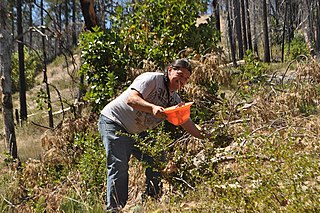
The Karuk people are an indigenous people of California, and the Karuk Tribe is one of the largest tribes in California. Karuks are also enrolled in two other federally recognized tribes, the Cher-Ae Heights Indian Community of the Trinidad Rancheria and the Quartz Valley Indian Community.
The Tuolumne Band of Me-Wuk Indians is a federally recognized tribe of Miwok people in Tuolumne County, California. The Tuolumne Band are central Sierra Miwok people. Annually, in September, the tribe holds an acorn festival and intertribal gathering.
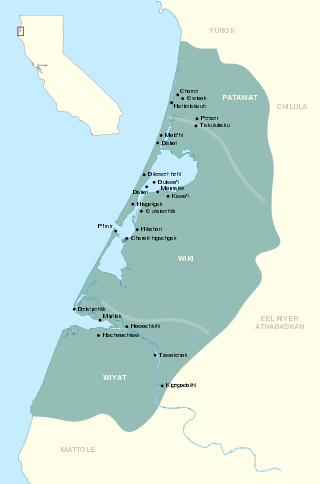
The Wiyot are an indigenous people of California living near Humboldt Bay, California and a small surrounding area. They are culturally similar to the Yurok people. They called themselves simply Ku'wil, meaning "the People". Today, there are approximately 450 Wiyot people. They are enrolled in several federally recognized tribes, such as the Wiyot Tribe, Bear River Band of the Rohnerville Rancheria, Blue Lake Rancheria, and the Cher-Ae Heights Indian Community of the Trinidad Rancheria.
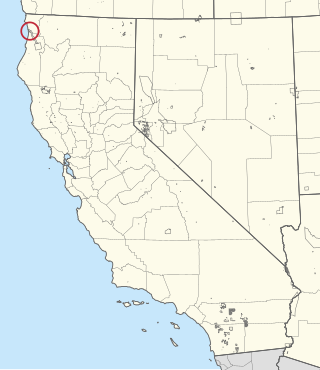
The Resighini Rancheria, located just south of Klamath, California, is a federally recognized tribe of Yurok people.
The Tolowa people or Taa-laa-wa Dee-ni’ are a Native American people of the Athabaskan-speaking ethno-linguistic group. Two rancherías still reside in their traditional territory in northwestern California. Those removed to the Siletz Reservation in Oregon are located there.

The Yurok people are an Algic-speaking Indigenous people of California that has existed along the Hehlkeek 'We-Roy or "Health-kick-wer-roy" and on the Pacific coast, from Trinidad south of the river’s mouth almost to Crescent City along the north coast.
The Buena Vista Rancheria of Me-Wuk Indians of California is a federally recognized tribe of Miwok in Amador County, California. The Buena Vista Miwok are Sierra Miwok, an indigenous people of California.
The Big Lagoon Rancheria is a federally recognized tribe of Yurok and Tolowa Indians. They are located in Humboldt County, California, and their tribal headquarters is in Arcata, California.
The Big Sandy Rancheria of Mono Indians of California is a ranchería and federally recognized tribe of Western Mono Indians (Monache) located in Fresno County, California, United States. As of the 2010 Census the population was 118. In 1909, the Bureau of Indian Affairs (BIA) bought 280 acres (110 ha) of land for the Big Sandy Band of Western Mono Indians.
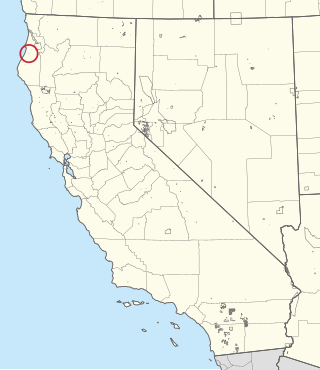
The Blue Lake Rancheria is a federally recognized tribe of Wiyot, Yurok, and Hupa Indians located northwest of the city of Blue Lake in Humboldt County, California on approximately 76 acres (0.31 km2). As of 2007, there were 53 enrolled members. As of the 2010 Census the population of Blue Lake Rancheria was 58.

The Bear River Band of the Rohnerville Rancheria is a federally recognized tribe of Mattole, Bear River and Wiyot people in Humboldt County, California.
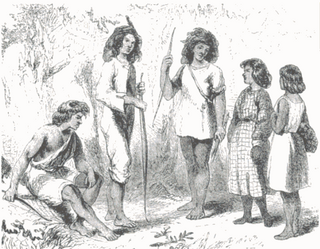
The Chetco are a tribe of Native Americans who originally lived along the lower Chetco River and Winchuck River in Curry County in the U.S. state of Oregon. The name Chetco comes from the word meaning "close to the mouth of the Chetco River" in their own language, which is part of the Athapascan languages. Although they were once one of the largest tribes on the Pacific coast of Oregon, "the last known full-blooded Chetco" living on the Chetco River died in 1940.
The Susanville Indian Rancheria is a federally recognized ranchería of Native Americans in northeastern California whose people are from the Washoe, Achomawi, Mountain Maidu, Northern Paiute, and Atsugewi tribes.
The Tolowa Dee-ni' Nation, previously known as Smith River Rancheria, is a federally recognized tribe of Tolowa people in Del Norte County, California. They are Athabascan people, distantly related to northern Athabascans of eastern Alaska and western Canada, as well as the Apache and Navajo peoples of the American Southwest.
The Yocha Dehe Wintun Nation is a federally recognized tribe of Wintun people, specifically Patwin people or southern Wintun, in Yolo County, California. They were formerly known as the Rumsey Indian Rancheria of Wintun Indians of California.

The Mooretown Rancheria of Maidu Indians of California is a federally recognized tribe of Concow and Maidu people in Butte County. Concow, or Konkow, people are the northwestern or foothill branch of the Maidu people, who traditionally spoke the Concow language

The Picayune Rancheria of Chukchansi Indians of California is a federally recognized tribe of indigenous people of California, affiliated with the Chukchansi subgroup of the Foothills Yokuts. The Picayune Rancheria, founded in 1912 and located in Coarsegold, California, covers 160 acres (1 km2) in Madera County and serves as the tribal land.

The Paskenta Band of Nomlaki Indians, or in their own language Nomlāqa Bōda, is a federally recognized tribe of Nomlaki people. The Nomlaki are Central Wintun, or River and Hill Nomlaki, an indigenous people of California, located in Tehama and Glenn counties.
The Wiyot Tribe, California is a federally recognized tribe of Wiyot people. They are the aboriginal people of Humboldt Bay, Mad River and lower Eel River of California.












